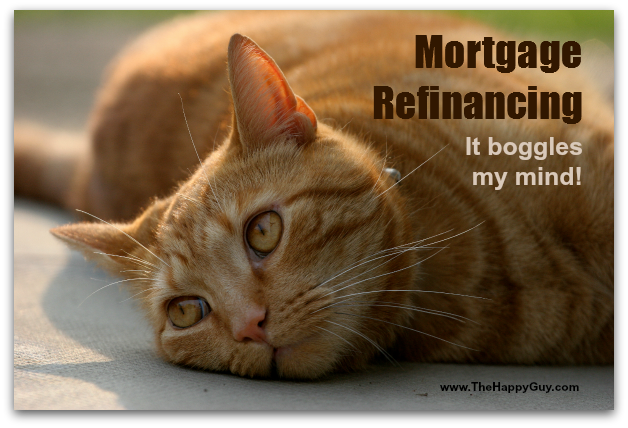Some things are obvious. Refinancing your mortgage is not. Here are all the things you need to consider to make sure that refinancing actually saves you money.
When to refinance your mortgage is a much more complicated question that might appear at first glance, especially if you want to save the most money.
There are many factors to consider before making the decision. And if you miscalculate, you might end up paying more in the end than if you left your mortgage as it currently stands, which would kind of defeat the point of refinancing.
I have been through the refinancing process, and it does tend to boggle the mind.
With that introduction, let us take a look at some of the issues you may encounter when trying to decide to refinance, and some of the reasons why you may or may not choose to do so.
Why refinance your mortgage?
Most people opt to refinance because they think the time is ripe to reduce their monthly payments through lower interest rates. This might or might not be the right time to take such that step, and that does depend on more than just the prevailing interest rate.
If you have an adjustable rate mortgage (ARM), you might want to switch to a fixed rate mortgage. This will depend largely on how interest rates might have risen or fallen since you first took out the mortgage. Sometimes you will find that the ARM rate has risen from its initial low point and now a fixed rate mortgage actually carries a lower rate. Other times a person may have a fixed rate mortgage that you signed up for many years back, so that is the opposite situation. There is a good explanation of fixed and variable rate mortgages here.
There are a number of reasons why you might be eligible for a lower interest rate now than when you first took out the loan, regardless of the structure of the loan. Over time, you might have improved you credit score and that can make you eligible for a lower interest rate. Or it could be that the state of the economy is such that lower rates are generally available – to you and to everyone else.
Why not refinance your mortgage?
It is dangerous to jump to conclusions. Start by understanding that refinancing is not free.A lot of paperwork has to be covered, risk has to be averted and profits have to be earned. In other words, the bank wants to earn money, make sure it doesn’t lose money and it costs them money to do the work.
First, you will have to pay a fee for applying for a refinance. This pays the cost to run a new credit check on you.
Then there is the cost for the lender to check your title and get title insurance, to make sure everything is still copacetic as it was on the day you took out your original mortgage.
Next, you will likely want a lawyer, and we all know that lawyers don’t work for peanuts. There will also be other legal fees.
In most cases, you will need to pay “points”. According to the Federal Reserve…
Points. A point is equal to 1 percent of the amount of your mortgage loan. There are two kinds of points you might pay.
The first is loan-discount points, a one-time charge paid to reduce the interest rate of your loan.
Second, some lenders and brokers also charge points to earn money on the loan. The number of points you are charged can be negotiated with the lender.
Cost range = 0% to 3% of the loan principal
There is something called an origination fee.
And let us never forget taxes.
There may even be other costs not mentioned above. When I used the word “complicated” above, I was not kidding.
Let’s do the math
The decision of whether or not to refinance in order to save money comes down to math. First you need to calculate all of the closing costs involved to determine how much it will cost you up front.
Then you need to look at how much money you will save each month after you refinance.
Next, you have to calculate how many months it will take for the money you will save by refinancing to pay for the costs you incurred to process the new mortgage – and how much interest you will pay over that period to finance the costs of refinancing. The bottom line is this: will the savings from refinancing be more than the costs of refinancing. If the answer is “yes”, go for it. It the answer is “no”, go for a soda…
You can use the free mortgage calculator at Credit Sesame to help you figure out if you should refinance.
Here is an example for you to follow: Suppose you refinance, and the up front costs (legal, administrative, credit check, etc.) run you $12,000. Suppose further that you save $400 a month with the lower interest rate on the refinanced mortgage. It would take you two and a half years to recoup the upfront costs of refinancing. If you will be remaining in the house for more than 10 months, you should refinance.
Will there be penalties?
Just in case that seemed a little too easy, did I mention “penalties”?
Before even thinking about refinancing, check your current mortgage for a clause that might penalize you for paying it off early. Did you know that when you refinance a mortgage, what you are doing is paying off the original loan in its entirety? And that then you are signing up for a brand new load, starting “afresh”? There is usually a penalty for paying off the original loan earlier than agreed upon in the original documents, so refinancing will normally incur that penalty.
Think long-term
If you decide to refinance a 30-year mortgage (that you have already been paying for three or four years, for instance) to another 30-year mortgage, you might be paying less monthly, but you will be paying for a longer period of time. That means paying less principal right away and more interest. Over that longer period of time, you will end up paying more in interest payments than if you had stuck with your original mortgage.
The way a mortgage works is that you pay more of the interest at the beginning of the mortgage. So if, for example, you have a 30 year fixed rate mortgage for $200,000 at 5% interest, your monthly payments would be $1,073.64. However, that payment is broken down differently between interest and principal depending on how long you have been paying. Your first payment of $1,073.64 would consist of $240.31 in principal and $833.33 in interest. In contrast, your final payment would consist of $1,069.19 in principal and $4.45 in interest.
Now consider that since you are paying more interest than principal initially, you will not have even paid off half of your loan after 15 years. If you were to refinance halfway through your first mortgage you would be taking out a mortgage to pay off more than half of what you borrowed initially and on top of that, the initial payments for the new loan will again be mostly interest. It is clear that refinancing for the same loan term can cost you a lot in interest.
In other words, “starting over” at the beginning of a new 30-year mortgage isn’t always such a good idea. It might be more profitable for you to refinance that 30-year mortgage to a 25-year mortgage, even if your monthly payments remain almost the same – because your overall costs should go way down. If you have a good credit score and have built up equity in your house then you might still get lower monthly payments without extending your debt and paying more interest over the long run.
And the verdict is?
All of the above is not to say that you should avoid refinancing if you can get a lower rate. The money you save could be substantial under the right circumstances. Ask questions. Demand answers. make sure you understand all the implications. You can use the information in this article as a guide to the type of questions to ask; every situation is different, so there might be other questions you’ll need to ask, too. You can find more helpful information that should make the deciding easier at Credit Sesame in the US or RateHub in Canada.
More reading on this topic:
The Pros and Cons to Refinancing Your Mortgage
Know When to Refinance Your Home



